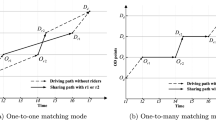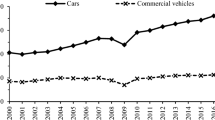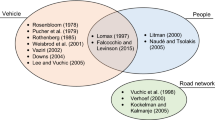Abstract
Some stops on busy bus lines regularly suffer from bus bunching, which refers to a bus arriving with a little headway to its predecessor. This phenomenon increases scheduling difficulties and has a negative impact on the passenger experience due to unreasonable scheduling. The conventional holding strategy aims to alleviate this problem by holding buses at control points. However, the holding strategy has the drawbacks of creating large deviations from the original schedule and prolonging passenger waiting time when confronted with traffic congestion. This study proposes an innovative short-turning strategy to alleviate bus bunching by the deliberate conversion of a few regular trips to short-turning trips. A nonlinear optimisation model is developed by rescheduling a set of trips using the short-turning strategy to minimise schedule deviation from the original schedule. The nonlinear short-turning model is then converted into a linear form that is solvable by CPLEX. Based on real data from the Yuntong 111 bus line in Beijing, China, the proposed short-turning strategy is deployed in a simulation experiment. The results show that the short-turning strategy is superior at alleviating bus bunching than the alternatives of no control strategy and the holding strategy. Compared with no control strategy, the short-turning strategy can achieve a more than 43.44% reduction in schedule deviation and significantly reduce total passenger waiting time by up to 8.99%.





Similar content being viewed by others
References
Babar M, Arif F (2019) Real-time data processing scheme using big data analytics in internet of things based smart transportation environment. J Amb Intel Hum Comp 10:4167–4177
Bartholdi JJ, Eisenstein DD (2012) A self-coordinating bus route to resist bus bunching. Transp Res Part B Methodol 46(4):481–491
Berrebi SJ, Watkins KE, Laval JA (2015) A real-time bus dispatching policy to minimize passenger wait on a high frequency route. Transp Res Part B Methodol 81:377–389
Canca D, Barrena E, Laporte G, Ortega FA (2016) A short-turning policy for the management of demand disruptions in rapid transit systems. Ann Oper Res 246(1–2):145–166
Ceder A (2007) Public transit planning and operation: theory, modeling and practice. Elsevier, Amsterdam
Chen XM, Yu L, Zhang YS, Guo JF (2009) Analyzing urban bus service reliability at the stop, route, and network levels. Transp Res Part A Policy Pract 43(8):722–734
Chen X, Hellinga B, Chang CZ, Fu LP (2015) Optimization of headways with stop-skipping control: a case study of bus rapid transit system. J Adv Trans 49(3):385–401
Cortés CE, Sáez D, Milla F, Núñez A, Riquelme M (2010) Hybrid predictive control for real-time optimization of public transport systems operations based on evolutionary multi-objective optimization. Transp Res Part C Emerg Technol 18(5):757–769
Delgado F, Munoz JC, Giesen R, Cipriano A (2009) Real-time control of buses in a transit corridor based on vehicle holding and boarding limits. Transp Res Rec 2090:59–67
Delgado F, Munoz JC, Giesen R (2012) How much can holding and/or limiting boarding improve transit performance? Transp Res Part B Methodol 46(9):1202–1217
Fu L, Yang X (2002) Design and implementation of bus-holding control strategies with real-time information. Transp Res Rec 1791:6–12
Ghaemi N, Goverde RMP, Cats O (2016) Railway disruption timetable: short-turnings in case of complete blockage. In: 2016 IEEE international conference on intelligent rail transportation (ICIRT), pp 210–218
Ghaemi N, Cats O, Goverde RMP (2017) A microscopic model for optimal train short-turnings during complete blockages. Transp Res Part B Methodol 105:423–437
Hernández D, Muñoz JC, Giesen R, Delgado F (2015) Analysis of real-time control strategies in a corridor with multiple bus services. Transp Res Part B Methodol 78:83–105
Ibarra-Rojas OJ, Delgado F, Giesen R, Muñoz JC (2015) Planning, operation, and control of bus transport systems: a literature review. Transp Res Part B Methodol 77:38–75
Leffler D, Cats O, Jenelius E, Burghout W (2017) Real-time short-turning in high frequency bus services based on passenger cost. In: Proceedings of the 5th IEEE international conference on models and technologies for intelligent transportation systems, MT-ITS 2017, pp 861–866
Li SK, Liu RH, Yang LX, Gao ZY (2019) Robust dynamic bus controls considering delay disturbances and passenger demand uncertainty. Transp Res Part B Methodol 123:88–109
Newell GF (1974) Control of pairing of vehicles on a public transportation route, two vehicles, one control point. Transp Sci 8(3):248–264
Liu Z, Yan Y (2013) Bus stop-skipping scheme with random travel time. Transp Res Part C Emerg Technol 35(9):46–56
Liu J, Chen M, Liu HF (2020) The role of big data analytics in enabling green supply chain management: a literature review. J Data Inf Manage 2:75–83
Petit A, Ouyang YF, Lei C (2018) Dynamic bus substitution strategy for bunching intervention. Transp Res Part B Methodol 115:1–16
Ramesh, R, Divya, G, Dorairangaswamy MA, Unnikrishnan KN, Joseph A, Vijayakumar A, Mani A (2019). Real-time vehicular traffic analysis using big data processing and IoT based devices for future policy predictions in smart transportation. In: 2019 International conference on communication and electronics systems (ICCES). IEEE
Petit A, Lei C, Ouyang YF (2019) Multiline bus bunching control via vehicle substitution. Transp Res Part B Methodol 126:68–86
Sánchez-Martínez GE, Koutsopoulos HN, Wilson NHM (2016) Real-time holding control for high-frequency transit with dynamics. Transp Res Part B Methodol 83:1–19
Tirachini A, Cortés CE, Jara-Díaz SR (2011) Optimal design and benefits of a short turning strategy for a bus corridor. Transport 38(1):169–189
Yan YD, Meng Q, Wang SA, Guo XC (2012) Robust optimization model of schedule design for a fixed bus route. Transp Res Part C Emerg Technol 25:113–121
Yan ZW, Ismail H, Chen LJ, Zhao XD, Wang L (2019) The application of big data analytics in optimizing logistics: a developmental perspective review. J Data Inf Manage 1:33–43
Zhang M, Wang Y, Su S, Tang T, Ning B (2018) A short turning strategy for train scheduling optimization in an urban rail transit line: The case of Beijing Subway Line 4. J Adv Transp:1–19
Zhao J, Dessouky M, Bukkapatnam S (2006) Optimal slack time for schedule-based transit operations. Transp Sci 40(4):529–539
Funding
This work was supported by grants from the National Natural Science Foundation of China (nos. 71722007 & 71931001), the Funds for First-class Discipline Construction (XK1802-5), the Key Program of NSFC-FRQSC Joint Project (NSFC no. 72061127002 and FRQSC no. 295837), the Fundamental Research Funds for the Central Universities (buctrc201926), and the China Postdoctoral Science Foundation (no. 2019M660426).
Author information
Authors and Affiliations
Corresponding author
Ethics declarations
Conflict of interest
The authors declare that they have no conflict of interest.
Ethical approval
This article does not contain any studies with human participants performed by any of the authors. This article does not contain any studies with animals performed by any of the authors. This article does not contain any studies with human participants or animals performed by any of the authors.
Informed consent
There is no individual participant included in the study.
Additional information
Publisher's Note
Springer Nature remains neutral with regard to jurisdictional claims in published maps and institutional affiliations.
Rights and permissions
About this article
Cite this article
Tian, S., Li, X., Liu, J. et al. A short-turning strategy to alleviate bus bunching. J Ambient Intell Human Comput 13, 117–128 (2022). https://doi.org/10.1007/s12652-020-02891-2
Received:
Accepted:
Published:
Issue Date:
DOI: https://doi.org/10.1007/s12652-020-02891-2




